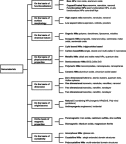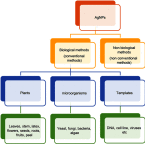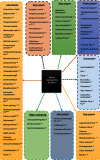Green nanotechnology: a review on green synthesis of silver nanoparticles - an ecofriendly approach
- PMID: 31371949
- PMCID: PMC6636611
- DOI: 10.2147/IJN.S200254
Green nanotechnology: a review on green synthesis of silver nanoparticles - an ecofriendly approach
Abstract
Background: Nanotechnology explores a variety of promising approaches in the area of material sciences on a molecular level, and silver nanoparticles (AgNPs) are of leading interest in the present scenario. This review is a comprehensive contribution in the field of green synthesis, characterization, and biological activities of AgNPs using different biological sources. Methods: Biosynthesis of AgNPs can be accomplished by physical, chemical, and green synthesis; however, synthesis via biological precursors has shown remarkable outcomes. In available reported data, these entities are used as reducing agents where the synthesized NPs are characterized by ultraviolet-visible and Fourier-transform infrared spectra and X-ray diffraction, scanning electron microscopy, and transmission electron microscopy. Results: Modulation of metals to a nanoscale drastically changes their chemical, physical, and optical properties, and is exploited further via antibacterial, antifungal, anticancer, antioxidant, and cardioprotective activities. Results showed excellent growth inhibition of the microorganism. Conclusion: Novel outcomes of green synthesis in the field of nanotechnology are appreciable where the synthesis and design of NPs have proven potential outcomes in diverse fields. The study of green synthesis can be extended to conduct the in silco and in vitro research to confirm these findings.
Keywords: green synthesis; microorganism; plant mediated synthesis; silver bioactivity.
Conflict of interest statement
The authors report no conflicts of interest in this work.
Figures
References
-
- Prasad R, Swamy VS. Antibacterial activity of silver nanoparticles synthesized by bark extract of Syzygium cumini. J Nanopart. 2013;2013:6. doi: 10.1155/2013/431218 - DOI
-
- Isaac R, Sakthivel G, Murthy C. Green synthesis of gold and silver nanoparticles using Averrhoa bilimbi fruit extract. J Nanotechnol. 2013;2013:6. doi: 10.1155/2013/906592 - DOI
-
- Jagtap UB, Bapat VA. Green synthesis of silver nanoparticles using Artocarpus heterophyllus Lam. seed extract and its antibacterial activity. Ind Crops Prod. 2013;46:132–137.
-
- Phanjom P, Borthakur M, Das R, Dey S, Bhuyan T. Green synthesis of silver nanoparticles using leaf extract of Amaranthus viridis. Int J Nanotechnol Appl. 2012;6:53–59.
-
- Ghoreishi SM, Behpour M, Khayatkashani M. Green synthesis of silver and gold nanoparticles using Rosa damascena and its primary application in electrochemistry. Phys E. 2011;44(1):97–104.
Publication types
MeSH terms
Substances
LinkOut - more resources
Full Text Sources




